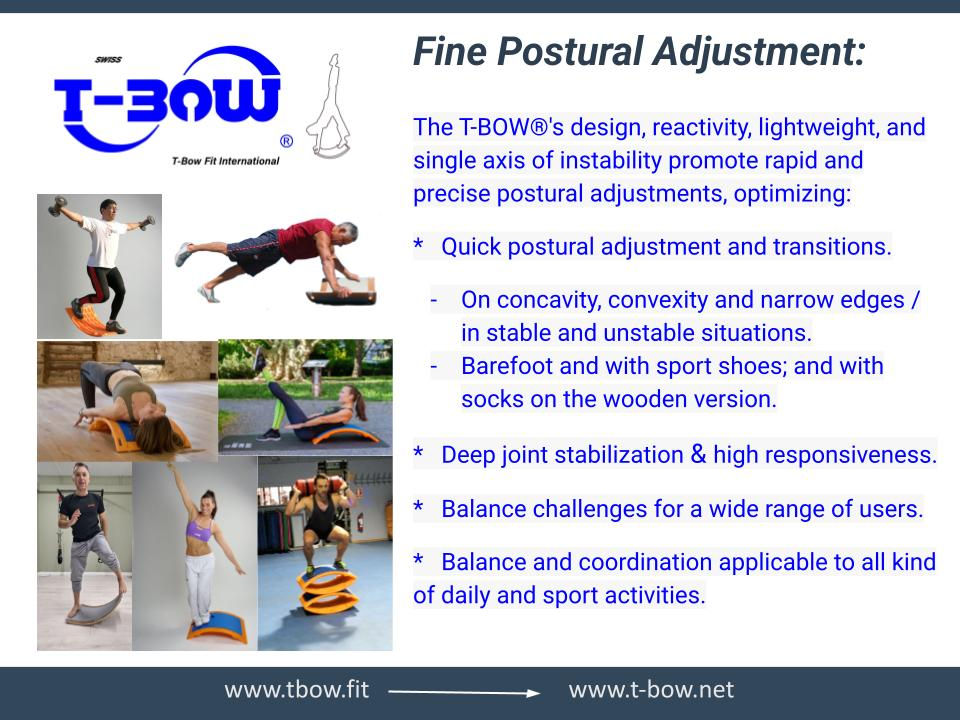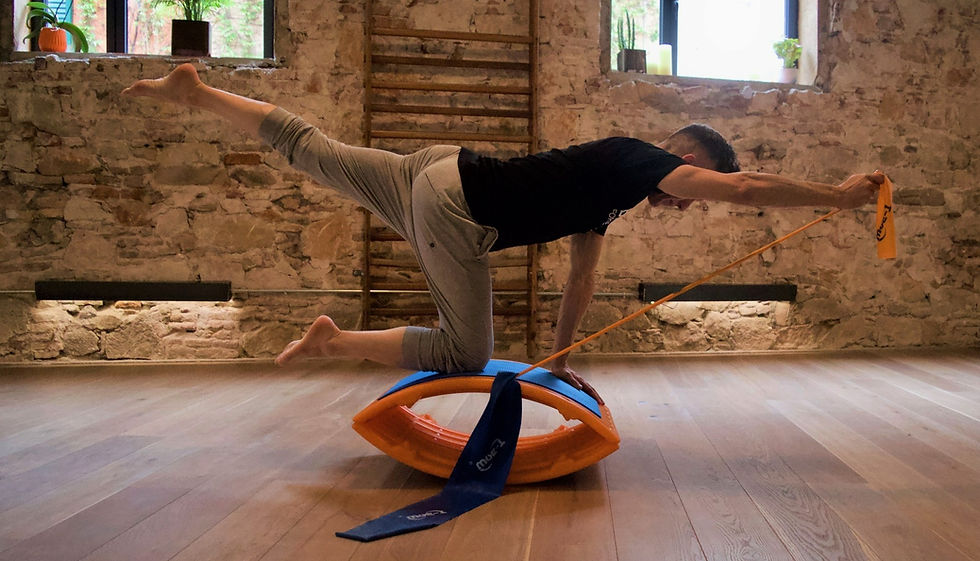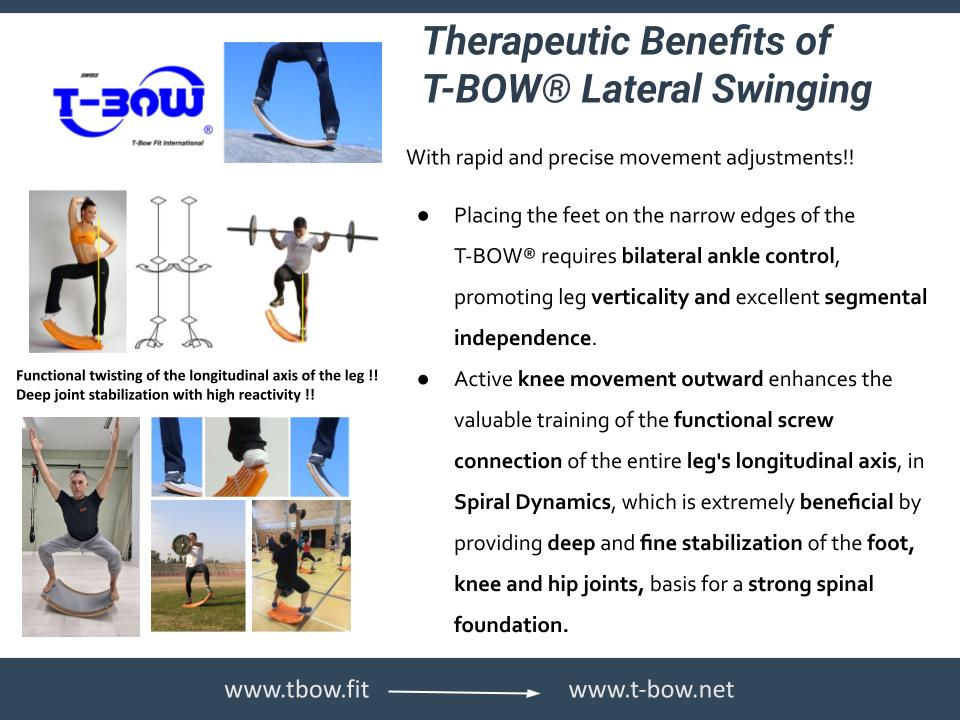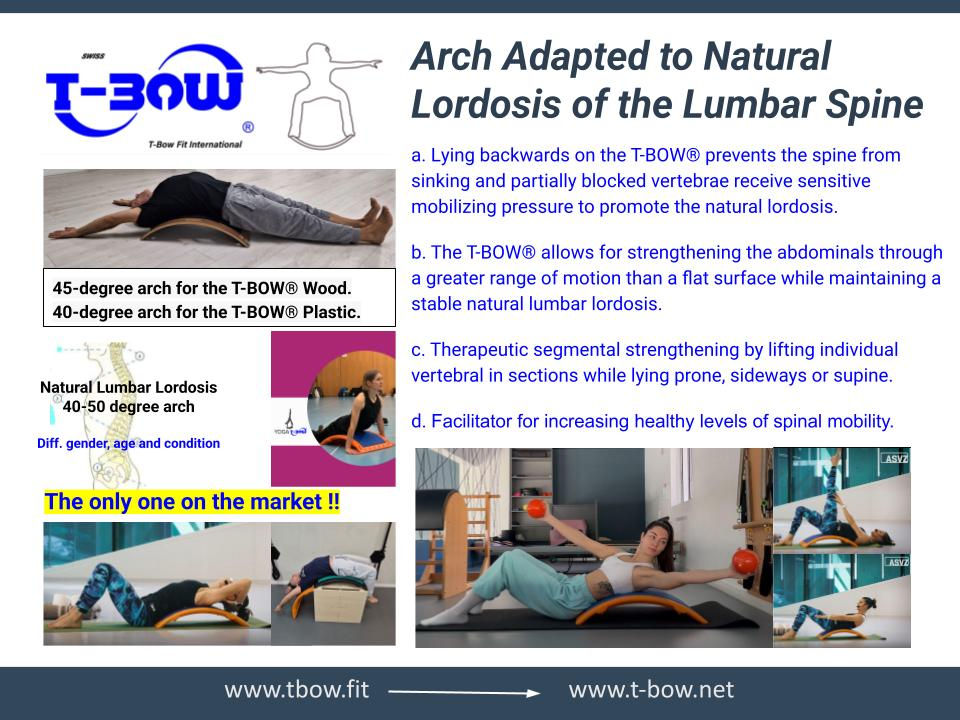Postural Education with T-BOW®
- T-BOW TRAINING AND THERAPY
- Jan 20, 2022
- 9 min read
Updated: Aug 16

Postural Education with T-BOW®
By Joaquím Reverter-Masià, Daniel Picó-Benet and David Ribera-Nebot
The T-BOW® is a multifunctional bow for education, training and movement therapy. Ideal for group sessions and personalized training. Sandra Bonacina is the creator of the T-BOW®, a training tool that she has developed together with Víctor Denoth, both university professors of physiotherapy, fitness and training at the Institute of Movement and Sports Sciences at the University of Zurich (Switzerland). The T-BOW® is made of wood or synthetic fiber HDPE, covered with a mat on the convex part and with a slightly grainy layer on the concave part.
It is easy to transport, light, very manageable, non-slip, stable and stackable in a very small space. Openings on the edges allow easy attachment of T-Bands or elastic bands. It can be used from both sides, it allows training in a very small space and its multifunctionality favors the comprehensive training of coordination, conditional and cognitive abilities.

Fine Postural Adjustment
The T-BOW®'s design, reactivity, lightweight, and single axis of instability promote rapid and precise postural adjustments, optimizing:
* Quick postural adjustment and transitions.
- On concavity, convexity and narrow edges / in stable and unstable situations.
- Barefoot and with sport shoes; and with socks on the wooden version.
* Deep joint stabilization & high responsiveness.
* Balance challenges for a wide range of users.
* Balance and coordination applicable to all kinds of daily and sport activities.

The concepts of postural education described here, as well as its implementation with the T-BOW®, are based on the philosophy and practical methodologies of the master of teachers in human motor skills Francisco Seirulo Vargas.
Concepts about postural education
Posture is a consequence and manifestation of each person's body scheme. The body scheme is the knowledge, which is progressively completed, of our body in rest and movement, perceiving its parts and the whole, as an instrument of our relationship with the environment. This knowledge is structured or manifested at 3 levels:
Somatognosia: knowledge of sizes, shapes, dimensions, etc. of my own body (perceptive level).
Mecanognosia: knowledge of how my body works in motion (behavioral level).
Iconognosia: knowledge of my body image and meaning of my body (significant level).
We live globally the knowledge of the 3 components of the body scheme. These components are compensated with each other and form a functional unit that interacts constantly. Our body scheme, and posture as its manifestation, have more or less value in our lives according to different moments. It is always influenced and depends on the cognitive, affective and emotional aspects of each person. The knowledge of our body by parts in an analytical way (laterality) or integrating all the parts into a whole (attitude) will be facilitated and favored by good relaxation and breathing, at all levels of the body scheme (somatognosia, mecanognosia and iconognosia). Attitude is the body posture that is established and modified throughout life as a result of the action of external and internal agents on the structure of our body.
External factors:
Continuous action of gravity (constant modifications and force balance).
Use of utensils (transient modifications and deterioration of osteo-articular mechanics with possible incorrect muscle tone developments).
Social customs and habits (transitional modifications and possible deterioration of correct hygienic-postural habits).
Internal factors:
Hereditary (permanent and not very modifiable).
Emotional situations (permanent or transient that modify the posture).
Muscle tone (constant relationship between the muscular and nervous system).
Motor education tries to improve and solve the problems caused by muscle tone and the action of gravity on our body. Each postural situation requires a different tonic state. The tone of rest, tone of attitude (pre-action posture) and tone of action are distinguished. The postural tone is the sum of the tone of rest and attitude. The result of our action on gravity is static or postural balance and dynamic balance or rebalance. We distinguish some currents or perspectives in relation to postural education:
Hygienic-re-educational (postureal health in daily and working life, and re-education of postural problems).
Expressive-creative (the posture in aesthetics, shows and sports).
Educational (postural education in school and life, and suppressive adjuvant training in sports).
Integrating the three currents, we select the specific resources of motor education-training for the development of postural education: Education of the body scheme (laterality and attitude) and its facilitating factors (relaxation and breathing). We highlight at the attitude level the means to act on tone and the action of gravity: balanced muscle development (anti-gravitatory muscles and the rest), maintenance of joint mobility (flexibility and elasticity), knowledge and practice of the relationships between the center of gravity and the basis of support (at the segmental and global level), education of breathing and relaxation. We highlight the relaxation that we improve through the improvement of perception capacities and the improvement of tonic control. Both from a static perspective through attitude and from a dynamic perspective through dynamic coordination, at the segmental and global level. Supressive adjuvant training: improvement of the basic coordination capacities of the body areas that intervene preferentially in the specific techniques, balance of muscle balance in the most important protagonist-antagonist groups of the preferred techniques, tendon-articular discharge, joint mobility, muscle elasticity and mechanical understanding of the specific techniques.

Continuing with the application of the concepts of master Seirul·lo, to achieve holistic postural optimization, preferential interactions must be developed between all the structures that constitute the person, both in static and in dynamic situations and the links between them.

Postural education with T-BOW®
From the specific resources of movement education-training, we have selected some practical and special examples of postural education that can be developed in a differential way with the T-BOW®. Its orientation is focused on obtaining good postural health in the field of fitness and wellness, to collaborate effectively with the overall health of the person.
We will focus on one of the alternatives that make the T-BOW® extraordinarily exceptional: its training possibilities for static and dynamic balance situations when used on its concave surface (unstable rocking position).
Another level is to place one T-BOW® on top of the other (convex surfaces in contact or concave surfaces in contact) to achieve more swing amplitude and inertia.
The differential actions with their infinity of options are the swings (longitudinal and transverse) seated and with individual support of feet or hands, and the swings in simultaneous support of feet and hands.

Examples of postural education exercises with the T-BOW® in the rocker position (static and dynamic balance in a swing situation):
Activity of the arms during the swing in support of the feet, sitting or in quadrupedia. Activity of the legs during the swing in support of hands or arms. E.g. during swaying: simultaneous, asymmetric and alternative movements of arms/legs; segmental accelerations and decelerations; segmental ballistic actions followed by pendulums; completing the movement of an arm/leg with the counterpart; wavy segmental movements.
Activity of differentiation of the hip, trunk, shoulder girdle or head during a swing in support of feet, hands, sitting or in quadrupedia. Ex: fix all parts except one that we mobilize (side and frontal inclinations of the trunk, rotations of the trunk and shoulder girdle, hip and head mobilizations).
Swelling sequence in support of feet and adopt a static posture. Ex: from the swing, balance on the T-BOW® in semi-flexion of legs with arms extended upwards.
Swing sequence in support of hands with the body extended and adopt a static posture. Ex: from the swing, balance on the T-BOW® with outstretched arms and with the support of a single foot.
Transition from one balance posture to another by varying the forms of support. Ex: from longitudinal swinging on feet, to a transverse swinging posture.
Sequences of change of posture varying the number of supports. Ex: from longitudinal balancing in quadrupedia, to triple support swinging (without a foot), to double support (foot-hand), to swinging a support (foot) changing feet in front and behind.
Adoption of a postural balance prior to a swinging action. Ex: balance in flexion of arms over the transverse T-BOW® and step to a balance of arms with extended body alternating lateral movements of the legs. Competition games are interesting to achieve a certain number of swings.
Interiorization of balance postures through work in front of a mirror and musical stimulation.
Adoption of different static postures during different swaying sequences. Ex: swinging sitting and stop with arms up, plus swinging in support of hands in facial bridge position and stop in dorsal bridge position.
Progressive passage from a global movement to a local one. Ex: successive step from the swing in support of the feet to the maintenance of the balance while one arm performs rotations.
From a swing in support of feet (hands, mixed or sitting), create situations of imbalance (e.g. sudden rotation action, reception of a weighed ball, fight with an adversary with/without a mobile, jump...) and then achieve a situation of static balance.
Discriminate the amplitudes of the swing in support of feet/hands with the amplitude of the movement of arms/legs. Ex: short foot swing and wide brace.
Discriminate with swing speeds in support of feet/hands with the speed of the movement of arms/legs. Ex: slow foot swing and fast foot swing (e.g.: 2/6).
Maintain the same speed of respiratory function for a swing at slow, medium or fast speed; or vice versa.


All the above examples can also be applied to the most differential and unique situations that can be achieved with the T-BOW®: combination of the swaying with the T-BOW® with the actions of the arms (and to a lesser extent also of the legs) with the T-Band (elastic bands).
In these circumstances, the richness of postural education increases significantly when we combine and alternate the following parameters:
Piernas en equilibrio estático o balanceo dinámico.
Brazos en equilibrio estático o balanceo dinámico.
Acciones de brazos con las T-Bands en condiciones estáticas o dinámicas.
Acciones de piernas con las T-Bands en condiciones estáticas o dinámicas.
Ex: transverse swinging on feet and dynamic lateral actions of the arms with the T-Band, to move to a static posture with relaxation of one arm and keeping the other in static tension up, and then continue with the dynamic swing of feet while the last arm is relaxed and a dynamic action of the other begins. These concepts are equally significant and differential, when during the swaying with the T-BOW®, instead of the T-Bands we use other moving materials such as dumbbells, bars and balls.

From a therapeutic point of view, T-BOW® is used to stabilize the foot and knee joints. The balances performed prophylactically decrease the hyper-extension of the joints of the foot and prevent inflammation of the periosteum (periostitis) in the legs or inflammation of the Achilles tendon. Likewise, the outward pressure and the external rotation of the knees favor a functional screwing of the longitudinal axis of the leg. The stabilization work favors a longitudinal axis of the straight leg and an optimal load of the leg joints. It is especially suitable for O- or X-shaped legs (genu varum and varus) and for knee problems. Through regular training, the pains of the joints of the foot and knee can disappear.

Therapeutic Benefits of T-BOW® Lateral Swinging
With rapid and precise movement adjustments!!
Placing the feet on the narrow edges of the T-BOW® requires bilateral ankle control, promoting leg verticality and excellent segmental independence.
Active knee movement outward enhances the valuable training of the functional screw connection of the entire leg's longitudinal axis, in spiral dynamics, which is extremely beneficial by providing deep and fine stabilization of the foot, knee and hip joints, basis for a strong spinal foundation.

Maintaining balance, using the T-BOW® as a rocker, forces a work of stabilization of the legs, trunk and shoulder girdle, and also strongly activates the back and buttocks. Asymmetric works, which acquire a special 45 richness and precision during swaying, also allow the activation of deeper muscle groups and smaller intervertebral muscles. Using the convex surface of the T-BOW® (step position) there are also very practical and interesting postural education options; especially when the work is associated with the T-Bands on both sides or moving materials. On the other hand, the arc shape allows an anatomically correct trunk training. The trunk can be reinforced at different levels, selectively mobilizing different segments of the spine.

T-BOW® Arch Adapted to Natural Lordosis of the Lumbar Spine in Healthy Adults
a. Lying backwards on the T-BOW® prevents the spine from sinking and partially blocked vertebrae receive sensitive mobilizing pressure to promote the natural lumbar lordosis.
b. The T-BOW® allows for strengthening the abdominals through a greater range of motion than a flat surface while maintaining a stable natural lumbar lordosis.
c. Therapeutic segmental strengthening by lifting individual vertebral in sections while lying prone, sideways or supine.
d. Facilitator for increasing healthy levels of spinal mobility.
New alternatives to apply postural education-oriented exercises are possible by placing a T-BOW® on top of another on its concave sides so that we achieve a dynamic arched surface, or by combining the balances and rebalances between a T-BOW® in step position and another in rocking position. Finally, these exercises with T-BOW® must be carried out including simultaneously the optimization of cognitive, affective-social, emotional-volitive and expressive-creative abilities, if we really want to achieve a qualitative improvement in the meaning of our body and thus contribute to new structuring of the body scheme that manifest themselves in better postural health, so that our general state of health improves.
Bibliography:
Bonacina S (2005). The regassing training with the multifunctional rainingsbogen. Training tips from Sandra Bonacina. Fitness Tribune, 93: 112-113.
Bonacina S (2006). Training types T-Bow. "Tipos de entrenamiento con el T-BOW."
Reverter-Masià J (2004). Cualidad de vida, salud and active física. Documento Universidad Rovira i Virgili.
Seirul·lo Vargas F (1986). Entrenamiento coadyuvante. Apuntes deportation medical, 23, 38-41.
Seirul·lo Vargas F (1987). Manifestations of the motricidad. Documento INEFC Barcelona.
Authors:
Joaquin Reverter-Masià is co-coordinator of EEB Sport Training Barcelona, Doctor of Human Motor Sciences and Professor of Human Motor Science - Universities of Zaragoza and Lleida.
Daniel Picó-Benet is co-coordinator of EEB Sport Training Barcelona, Doctor of Human Motor Sciences and Professor of Human Motor Science at the Ramon Llull University of Barcelona.
David Ribera-Nebot, is co-coordinator of EEB Sport Training Barcelona, Doctor of Human Motor Sciences and Associate Professor of Human Motor Skills at the University of Lleida.









Comments